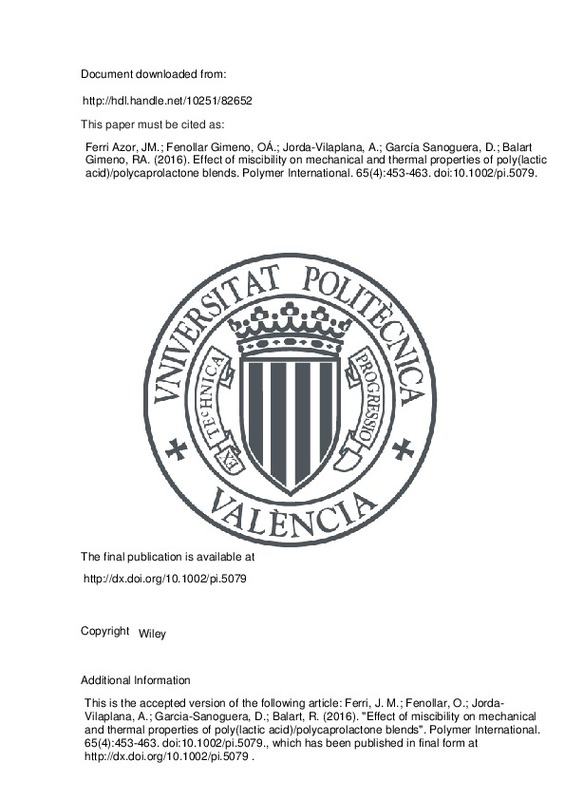Ferri Azor, JM.; Fenollar Gimeno, OÁ.; Jorda-Vilaplana, A.; García Sanoguera, D.; Balart Gimeno, RA. (2016). Effect of miscibility on mechanical and thermal properties of poly(lactic acid)/polycaprolactone blends. Polymer International. 65(4):453-463. https://doi.org/10.1002/pi.5079
Por favor, use este identificador para citar o enlazar este ítem: http://hdl.handle.net/10251/82652
|
Título:
|
Effect of miscibility on mechanical and thermal properties of poly(lactic acid)/polycaprolactone blends
|
|
Autor:
|

 Ferri Azor, José Miguel
Ferri Azor, José Miguel

 Fenollar Gimeno, Octavio Ángel
Fenollar Gimeno, Octavio Ángel
 Jorda-Vilaplana, Amparo
Jorda-Vilaplana, Amparo

 García Sanoguera, David
García Sanoguera, David

 Balart Gimeno, Rafael Antonio
Balart Gimeno, Rafael Antonio
|
|
Entidad UPV:
|
Universitat Politècnica de València. Instituto de Tecnología de Materiales - Institut de Tecnologia de Materials
Universitat Politècnica de València. Escuela Politécnica Superior de Alcoy - Escola Politècnica Superior d'Alcoi
|
|
Fecha difusión:
|
|
|
Resumen:
|
Binary blends based on poly(lactic acid) (PLA) and polycaprolactone (PCL) were prepared by melt mixing in a twin-screw co-rotating extruder in order to increase the low intrinsic elongation at break of PLA for packaging ...[+]
Binary blends based on poly(lactic acid) (PLA) and polycaprolactone (PCL) were prepared by melt mixing in a twin-screw co-rotating extruder in order to increase the low intrinsic elongation at break of PLA for packaging applications. Although PLA and PCL show low miscibility, the presence of PCL leads to a marked improvement in the ductile properties of PLA. Various mechanical properties were evaluated in terms of PCL content up to 30wt% PCL. In addition to tensile and flexural properties, Poisson s ratio was obtained using biaxial extensometry to evaluate transversal deformations when axial loads are applied. Very slight changes in the melt temperature and glass transition temperature of PLA are observed thus indicating the low miscibility of the PLA PCL system. Field emission scanning electron microscopy reveals some interactions between the two components of the blend since the morphology is characterized by non-spherical polycaprolactone drops dispersed into the PLA matrix. In addition to the improvement of mechanical ductile properties, PCL provides higher degradation rates of blends under conditions of composting for contents below 22.5% PCL.
[-]
|
|
Palabras clave:
|
Poly(lactic acid) (PLA)
,
Polycaprolactone (PCL)
,
Binary blends
,
FESEM
,
Mechanical properties
,
Degradability
|
|
Derechos de uso:
|
Reserva de todos los derechos
|
|
Fuente:
|
Polymer International. (issn:
0959-8103
) (eissn:
1097-0126
)
|
|
DOI:
|
10.1002/pi.5079
|
|
Editorial:
|
Wiley
|
|
Versión del editor:
|
http://dx.doi.org/10.1002/pi.5079
|
|
Código del Proyecto:
|
info:eu-repo/grantAgreement/MINECO//MAT2014-59242-C2-1-R/ES/TECNICAS AVANZADAS DE PROCESADO PARA SISTEMAS ACTIVOS ENCAPSULADOS/
info:eu-repo/grantAgreement/GVA//GV%2F2014%2F008/
|
|
Descripción:
|
This is the accepted version of the following article: Ferri, J. M.; Fenollar, O.; Jorda-Vilaplana, A.; Garcia-Sanoguera, D.; Balart, R. (2016). "Effect of miscibility on mechanical and thermal properties of poly(lactic acid)/polycaprolactone blends". Polymer International. 65(4):453-463. doi:10.1002/pi.5079., which has been published in final form at http://dx.doi.org/10.1002/pi.5079 .
|
|
Agradecimientos:
|
This research was supported by the Ministry of Economy and Competitiveness - MINECO, ref. MAT2014-59242-C2-1-R. The authors also thank the Conselleria d'Educacio, Cultura i Esport - Generalitat Valenciana, ref. GV/2014/008 ...[+]
This research was supported by the Ministry of Economy and Competitiveness - MINECO, ref. MAT2014-59242-C2-1-R. The authors also thank the Conselleria d'Educacio, Cultura i Esport - Generalitat Valenciana, ref. GV/2014/008 for financial support.
[-]
|
|
Tipo:
|
Artículo
|







![[Cerrado]](/themes/UPV/images/candado.png)


